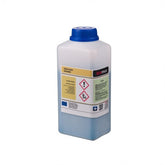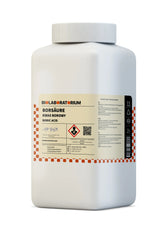Fuchsine acid – An intense acid dye in chemistry and microscopy
Fuchsin acid, also known as acid fuchsin, is a versatile acid dye that plays an important role in chemistry, microscopy, and other application areas. This intense red dye is characterized by its unique properties and application possibilities, which we will examine more closely in this article.
Chemical Structure and Properties
Fuchsin acid, with the chemical designation C.I. Acid Red 18, is an aromatic triphenylmethane dye. Its structure consists of a central carbon atom to which three phenyl rings are bonded. One of these rings carries a sulfo group (-SO3H), which gives the dye its acidic character.
Fuchsin acid is a strongly water-soluble dye that takes on an intense red color in water and aqueous solutions. This effect is caused by the delocalization of electrons in the aromatic system of the dye molecule, which leads to absorption of light in the visible spectral range.
An important characteristic of fuchsin acid is its sensitivity to pH changes. In acidic solutions, the dye is present in its protonated form and appears red. In basic solutions, however, it deprotonates and takes on a violet color. This color change makes fuchsin acid a useful pH indicator in chemical applications.
Use in Chemistry and Microscopy
Fuchsin acid finds diverse applications in chemistry and microscopy:
Staining of Tissues and Cells
In histology and cytology, fuchsin acid is frequently used for staining tissue and cell structures. Through selective binding to specific structures, such as cell nuclei or collagen fibers, the dye enables high-contrast visualization under the microscope.
Analytical Chemistry
In analytical chemistry, fuchsin acid serves as an indicator for the detection and quantification of various substances. For example, it can be used to detect formaldehyde, sulfur dioxide, or ammonia, as these compounds undergo color reactions with fuchsin acid.
Staining of thin-layer chromatograms
In thin-layer chromatography (TLC), Fuchsinsäure is used to make separated substances visible on the chromatogram. The dye binds to polar groups of the analytes, thus enabling the identification and quantification of the separated components.
Microscopic staining techniques
In microscopy, Fuchsinsäure is an important component of various staining methods. For example, it is used in Gram staining to distinguish between Gram-positive and Gram-negative bacteria. Fuchsinsäure is also used in Ziehl-Neelsen staining for the detection of acid-fast bacteria, such as Mycobacterium tuberculosis.
Production and application forms
Fuchsinsäure is produced industrially by condensation of benzaldehyde with aniline followed by sulfonation. The final product is available as a powder or aqueous solution and can be further processed depending on the application.
In practice, Fuchsinsäure is used in various application forms:
- Aqueous dye solutions for histological and cytological staining
- Concentrated stock solutions for dilution in analytical purposes
- Impregnated filter papers or test strips for chromatographic applications
- Dye-containing reagents for chemical detection reactions
The concentration and composition of dye solutions must be carefully adjusted according to the application to achieve optimal results.
Safety aspects and handling
Although Fuchsinsäure is considered safe in many applications, certain precautions must be observed during use:
- Fuchsinsäure can cause skin irritation upon contact and should therefore be handled with protective gloves.
- When handling Fuchsinsäure solutions, adequate ventilation should be ensured, as the dye can be harmful to health at higher concentrations.
- Waste containing Fuchsinsäure must be treated according to applicable disposal regulations.
For safe handling of Fuchsinsäure, it is recommended to consult the manufacturer's safety data sheets and observe the applicable laboratory regulations.
Conclusion
Fuchsinsäure is a versatile acid dye that plays an important role in chemistry, microscopy, and related disciplines. Its intense red coloration, pH sensitivity, and selective binding properties make it a valuable tool in analytical chemistry, histology, and cytology. With proper handling and application, Fuchsinsäure offers numerous possibilities for precise analyses, visualizations, and detection reactions.















